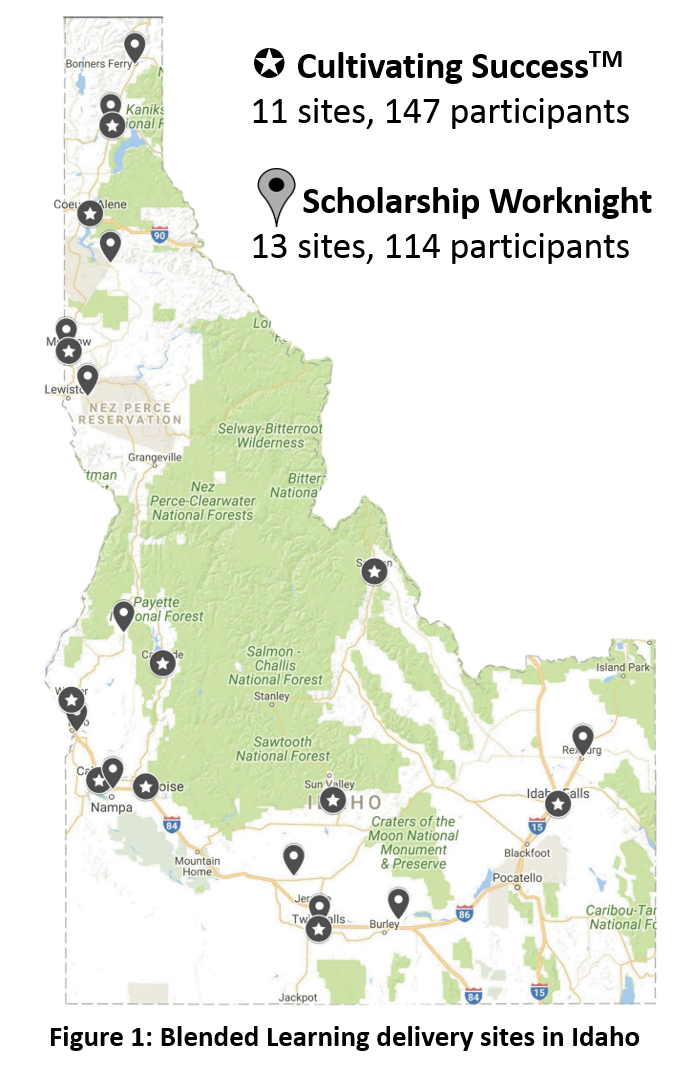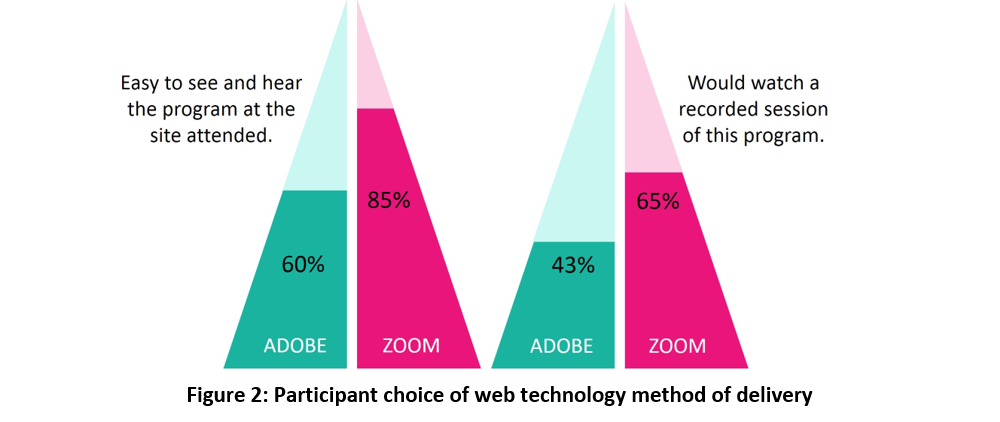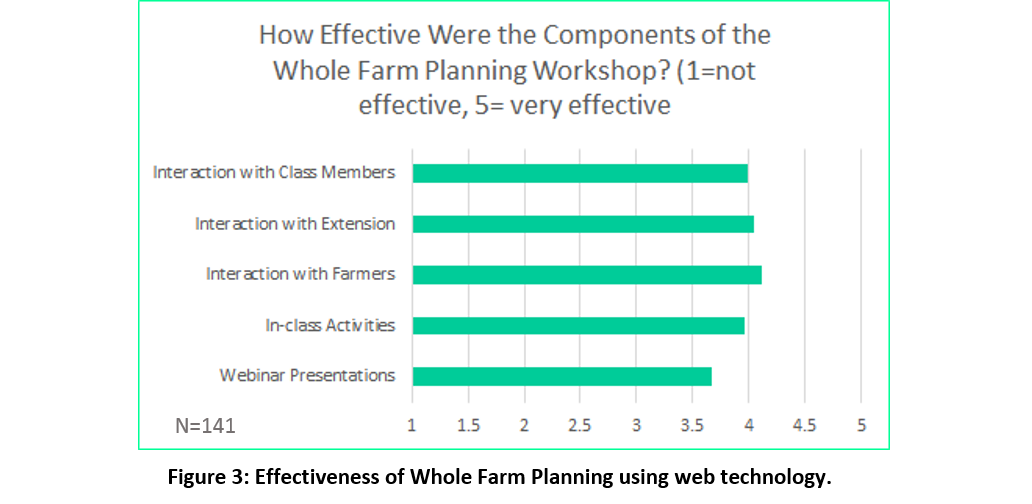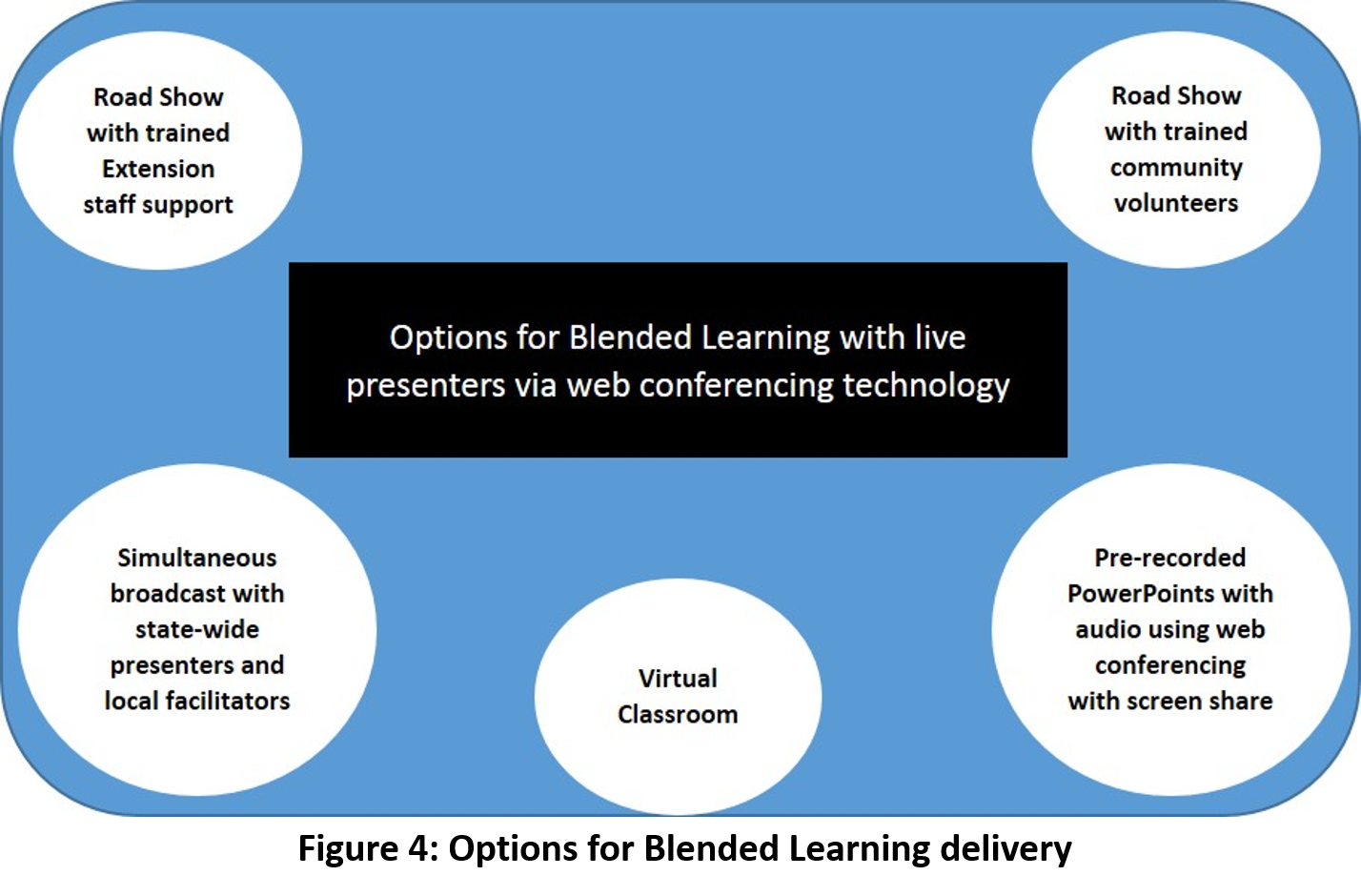Journal of the NACAA
ISSN 2158-9429
Volume 10, Issue 1 - June, 2017
Blended Learning: Connecting Expertise and Building Networks in Rural Communities
- Silkwood, G. , Extension Educator, University Of Idaho
Young, Montessa, Extension Educator, University of Idaho
Dolecheck, Suzann Hagan, Extension Educator, University of Idaho
Hamilton, Melissa, Extension Educator, University of Idaho
Kinder, Cindy, Extension Educator, University of Idaho
ABSTRACT
Extension programs are constantly changing, as are the ways to reach clientele. Doing more with less, utilizing specialists’ knowledge and reaching more clientele in a greater outreach are just a few of the factors that are influencing University of Idaho Extension educators to use Blended Learning delivery methods for greater impact.
Introduction
Idaho is a large state with challenging geography. It would take 15 hours to drive from end to end through mountain passes and along narrow river canyons. With dwindling travel budgets and increasing demands on educators’ time; getting resources and experts from campus or research and extension centers delivered to local communities is challenging. "Extension has historically been a leader in adopting new tools and practices (hybrid corn, irrigation, etc.) so why not information technology for educational program delivery" (Diem et al., 2011). Our educators have utilized blended learning to bring in specialists and deliver dynamic live presentations to areas where these programs may not have been viable before access to blended learning technology.
Blended learning is defined by the University of Central Florida as “classes where a portion of the traditional face-to-face instruction is replaced by web-based online learning” (UCF, 2017). Educator's Technology Blog goes on to say "In its basic and simplest definition, blended learning is an instructional methodology, a teaching and learning approach that combines face-to-face classroom methods with computer mediated activities to deliver instruction. The strengths of this instructional approach is its combination of both face to face and online teaching methods into one integrated instructional approach" (Kharbach, 2014). Blended learning is not a new concept to education; it is, however, a newer concept being utilized by University of Idaho Extension educators who have delivered blended learning programs throughout the state. "Blended learning builds on Extension's strength to connect the community while responding well to current financial pressures and the need for greater exposure" (Rich et al., 2011). University of Idaho (UI) Extension educators have expanded on the blended learning model, to include the delivery of content and presentations through connecting live presenters to live audiences, utilizing web conferencing software. The blended learning format can be applied to all disciplines in Extension work and has been applied to Agriculture, 4-H Youth Development, and Community Development programming in Idaho. Connections and networks have been made throughout the state from local stakeholders to resource specialists and content experts. Utilizing blended learning with live webinar technology has expanded the ability of Extension educators to increase the availability of expert information to our local county programs.
Methods
Our Response
Through blended learning programming, Extension educators have been able to expand the impact of their programs beyond their counties, increasing the outreach to rural communities statewide. Our Extension teams have delivered many programs through technology in blended learning formats. These teams consist of 10-20 networked Extension professionals throughout the state. The common thread of collaborating educators is blended learning programming and the sharing of resources, information, and expert content.
The programs Cultivating SuccessTM , Scholarship Worknight, and Area Sector Analysis Process (ASAP), have been and continue to be conducted in the fields of Agriculture, 4-H Youth Development, and Community Development in Idaho.
Cultivating SuccessTM used a road show format featuring Extension facilitation. Extension educators are trained in the delivery platform, they know the timeline and agenda and are aware of what is expected of them.
All planning team members and site facilitators for this program were Extension staff. This is an existing online class delivered through the eXtension Campus. The local Extension planning team used Moodle, Slack, and Zoom to manage the team and used GoToWebinar to broadcast a 16-week class in eight Extension locations across the state.
These locations featured video presentations with presenters (local farmers and educators) in multiple locations connecting 170 individuals across the state.  In-class discussions and activities were used to develop a \whole farm plan. The planning team mailed textbooks to all participants so they had written text as well as online content for the course.
In-class discussions and activities were used to develop a \whole farm plan. The planning team mailed textbooks to all participants so they had written text as well as online content for the course.
Scholarship Worknight was a simultaneous broadcast program that utilized local facilitator support at multiple locations across the state. This worknight used Zoom to broadcast to 20 sites across multiple states with local volunteer or Extension site facilitators. Community volunteers were encouraged to host and facilitate local classroom locations. These volunteers received facilitator training one week prior to the program to test technology equipment, teach facilitators duties and discuss sign in and handout materials. Sites for this presentation included local schools, libraries, Extension offices and student homes. There were multiple presentations given by Extension and Financial Aid Office content experts. All statewide presenters were broadcast via Zoom and site facilitators were responsible for promotion and marketing at their site locations. Materials and handouts were prepared and emailed to facilitators by Extension staff. One statewide moderator runs the PowerPoint presentation, switches speaker camera views and monitors the chat box for participant questions. Scholarship Worknight has helped students and families understand their post-secondary education options, as well as get a head start thinking about, finding and completing scholarship applications. This program has grown from 20 participants in one county to 114 participants in 13 counties throughout the state (see figure 1 for site locations).
Area Sector Analysis Process (ASAP) was delivered in a central location in the virtual meeting format. The class was a partnership with Western Rural Development Center through the University of Idaho and University of Nevada to help communities identify sustainable economic development for their communities. Presenters unavailable to travel to a remote location in Idaho were able to connect through the blended learning classroom through Zoom and deliver presentation materials live during the local workshops. The Extension educator served as a local site facilitator for this program and connected expert specialist located in Nevada and on campus to enable a rural community's participation in the ASAP program.
4-H Education days has utilized blended learning to allow 4-H students access to resources and presentations that would be difficult for them to reach in other circumstances. The Extension educator utilized an iPad lab to connect students to apps, websites, video clips and live streaming of large livestock shows to enhance 4-H members learning experience.
The American Pastured Poultry Producers Association offered an evening workshop in one location in Idaho. The blended learning virtual classroom format utilized classroom sharing and broadcast this event statewide so clientele in rural communities could take advantage of this live presentation through a virtual classroom connection.
Results and Discussion
Program Outcomes & Impacts
Getting feedback from blended learning participants takes forethought and consideration. Paper evaluations from each class attendee is not the most successful way of collecting feedback. SurveyMonkey, online polling, and quizzes through the learning management system as well as chat features are effective ways to collect feedback from attendees. Paper evaluations can be used but there must be a process clearly identified for delivering and collecting papers from each attendee at multiple locations.
Scholarship Worknight used SurveyMonkey to collect data and gained feedback on the user platform preference. The results show that participants favored Zoom over Adobe Connect (see figure 2).

The Cultivating SuccessTM Whole Farm Planning Workshop surveyed all participants (n=141) at the end of the one-day workshop. Questions were asked specifically about the blended learning components of the course. All components were rated as effective. The participants particularly thought the interaction with farmers, which were presenting through the webinar in most locations, was effective (see figure 3).
 Blended learning has been utilized in our Extension programs with a focus on the utilization of live web conferencing software. Through multiple formats of delivery, it has created broader connections, increased program outreach and impact, created new collaboration opportunities for Extension faculty and specialists, and has created greater engagement opportunities throughout the state for program participants.
Blended learning has been utilized in our Extension programs with a focus on the utilization of live web conferencing software. Through multiple formats of delivery, it has created broader connections, increased program outreach and impact, created new collaboration opportunities for Extension faculty and specialists, and has created greater engagement opportunities throughout the state for program participants.
Recommendations/Conclusions
Technology can be an excellent way to increase the impact of Extension programming to stakeholders throughout the state and is relevant for all content areas of Extension. Through collaboration among UI Extension professionals throughout the state, our findings have been similar to the conclusions of the hybrid learning model with Oregon State University, “implementing hybrid courses presents challenges but also offers potential rewards, including reaching larger and untapped audiences, realizing cost savings through increased faculty efficiency, sharing modular teaching resources, reducing travel time, and engaging Extension learners in a manner that may better reflect emerging lifelong learning preferences” (Hino and Kahn, 2016). In addition to these findings, it is important to know your audience, decide on a blended learning format, and choose the best technology available to teach the content of the course.
The first consideration in developing a blended learning program is to determine what type of format will work best for the program delivery. There are several class formats including:
1) Road Show with Extension staff facilitators
2) Road Show with volunteer facilitators
3) Virtual Classroom
4) Simultaneous broadcast with state-wide presenters and local facilitators
5) Pre-recorded presentations using PowerPoint or Zoom screen share features

Choosing the appropriate format is a necessary step to the successful preparation, planning, and implementation of a blended learning program. We have used these formats to deliver Cultivating SuccessTM, Area Sector Analysis Process, Scholarship Worknight, 4-H Education Days and Pasture Poultry Production Workshops.
The most important part of developing a blended learning class format is to consider the technology tools and resources available to you at the site where the presentation will be delivered. Using poor quality cameras, microphones and speakers will create a negative experience for the attendee and frustration for the presenter. Mid quality tools are affordable and available from a number of suppliers, taking the time to find, review and test them will be key to your participants having an engaging experience in your blended learning program.
Knowing your platform requirements for internet bandwidth will increase your program's success during the delivery. Most video conferencing platforms will list their requirements for bandwidth in the support sections of their website. It is common to find that a student utilizing the platform will need significantly lower bandwidth than the instructor. Important features to look for in video conferencing platforms are the ability to share your screen, call-in by phone, an ability to record the presentation and control the audio input of participants to minimize background noise.
Understanding the different formats of blended learning and pre-workshop training is important. Understanding the blended learning formats is a necessary step to the successful preparation, planning, and implementation of your blended learning program. Training site facilitators or users to troubleshoot the program and manage program “housekeeping” such as muting mics, adjusting camera views and speaker levels, are important to the learner’s experience. Blended learning does not rely solely on the online portion of the presentation. For attendees to get the most out of the session they must have peer to peer interaction and local networking with other class participants and the site facilitator. This can be facilitated through chat discussions, peer review pieces, peer presentations or other innovative ways. Overall we have found that utilizing blended learning in any format has increased our learner’s engagement and experience with our programs and presentations.
Literature Cited
Diem, K. G., Hino, J., Martin, D., & Meisenbach, T. (2011). Is Extension Ready to Adopt Technology for Delivering Programs and Reaching New Audiences? Journal of Extension, 49(6). Retrieved from https://www.joe.org/joe/2011december/a1.php
Hino, J., & Kahn, C. (2016). Hybrid Teaching in Extension: Learning at the Crossroads. Journal of Extension, 54(4). Retrieved from https://www.joe.org/joe/2016august/iw3.php
Kharbach, M. (2014, April 28). The Four Important Models of Blended Learning Teachers Should Know About [Blog post]. Retrieved from http://www.educatorstechnology.com/2014/04/the-four-important-models-of-blended.html.
Rich, S. R., Komar, S., Schilling, B., Tomas, S. R., Carleo, J., & Colucci, S. J. (2011). Meeting Extension programming needs with technology: A case study of agritourism webinars. Journal of Extension [online], 49(6) Article 6FEA4. Available at: http://www.joe.org/joe/2011december/a4.php
What is Blended Learning? (2011). Retrieved March 7, 2017, from https://blended.online.ucf.edu/about/what-is-blended-learning/
